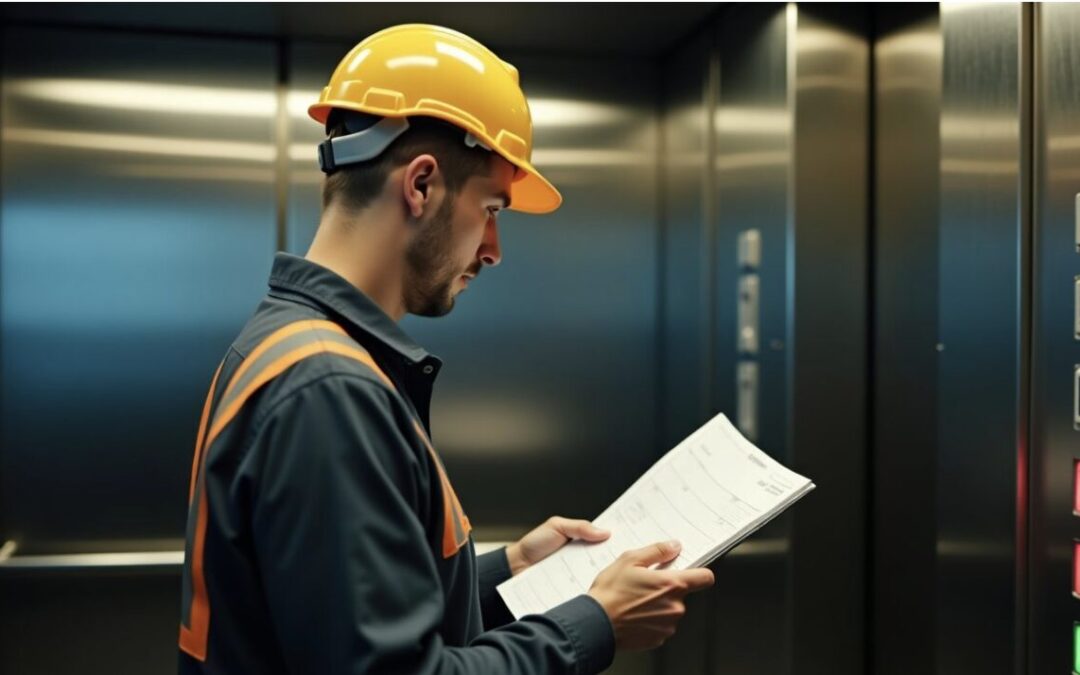When disaster strikes, building owners often find their elevator systems are not ready for emergencies. Each year, over 27,000 people get trapped in elevators during crisis events.
Digital elevator auditing gives you real-time data to spot problems before they become dangers. Your building can be safer today.
The Role of Elevators in Emergency Preparedness
Elevators serve as vital lifelines during emergencies, moving people and equipment quickly through buildings when every second counts. Modern digital auditing ensures these critical systems work when needed most, giving building managers the tools to keep occupants safe during crisis events.
Supporting efficient evacuation and rescue operations
Elevators play a key role in getting people out of buildings fast during an emergency. They help move large groups quickly and safely, which is vital for those who can’t use stairs.
Modern elevators come with backup power systems that keep them running even if the main power goes out. This means rescue teams can still use them to reach people in need.
In a crisis, every second counts. Digital elevator auditing ensures your vertical transportation systems are ready when they matter most.
Digital audits track how well elevators work during emergencies. They check if safety features like earthquake detection and automatic emergency calls are working right. Rescue operations become more effective when elevators can move personnel and supplies to where they’re needed.
For building owners, keeping these systems in top shape means better protection for everyone inside during power outages, severe weather, or other crisis situations.
Transporting emergency personnel and equipment
Beyond helping people leave buildings safely, elevators serve as vital transport for emergency teams. First responders need quick access to crisis areas, and elevators provide the fastest route up tall buildings.
Medical teams can move stretchers, defibrillators, and oxygen tanks through elevator cars much faster than carrying them up stairs. This speed can save lives during medical emergencies.
Digital elevator systems now track which floors need help first. Modern elevators have backup power systems that work during electrical outages – a must-have feature during storms or power failures.
These systems help building staff direct fire crews, paramedics, and police to exact locations without wasting precious minutes. Relief materials like water, food, and medical supplies also move more easily through working elevator systems after a disaster strikes.
What is Digital Elevator Auditing?
Digital elevator auditing uses smart tech to track elevator health and safety in real time. This system gives building owners instant access to vital data, helping them spot problems before they become major safety risks.
Overview of digital auditing technology
Digital elevator auditing uses smart tech to check elevator systems without manual inspections. This tech combines automation and AI tools that scan for problems and track performance around the clock.
Building owners gain access to real-time data about their elevator systems through secure platforms. The systems flag issues before they cause breakdowns or safety risks. Modern auditing tools can spot patterns that humans might miss, cutting down on errors that plague old paper-based methods.
These systems transform how buildings stay safe during emergencies. RPA (Robotic Process Automation) handles routine checks while staff focus on fixing actual problems. Blockchain features add extra security to audit records, making them tamper-proof.
The best part? These systems work 24/7, sending alerts if something needs attention right away. This means your property stays compliant with safety rules with less effort from your team.
Key components of digital elevator audits
Digital elevator audits give building owners a clear picture of their vertical transportation systems. These comprehensive evaluations include several vital elements that help maintain safety and performance in normal and emergency situations.
- Maintenance history review tracks past repairs and identifies patterns that might signal bigger problems.
- Equipment condition assessment checks motors, cables, doors, and control systems for wear or damage.
- Performance testing measures speed, leveling accuracy, and door operation times against industry standards.
- Code compliance verification ensures all systems meet current safety regulations and building codes.
- Safety feature testing confirms emergency phones, alarms, and backup power systems work correctly.
- Modernization needs analysis spots outdated components that should be upgraded for better safety.
- Service contract evaluation reviews current maintenance agreements to find gaps or cost savings.
- Financial impact reporting calculates the costs of repairs versus replacements to guide budget decisions.
- Real-time monitoring systems track elevator performance and alert staff to problems before they cause failures.
- Technology integration assessment checks how well elevator systems connect with building management software.
- Emergency response readiness confirms elevators will work properly during fire alarms or power outages.
- Documentation and reporting provides clear records that help with planning and prove compliance efforts.
Benefits of Digital Elevator Auditing in Crisis Situations
Digital elevator auditing gives building owners a clear edge during crisis events with faster response times and fewer system failures. Real-time data helps teams spot problems before they cause harm, making your property safer for everyone.
Real-time monitoring and diagnostics
Real-time monitoring gives building owners instant access to elevator data 24/7. This technology tracks how elevators run and spots problems before they become serious. IoT systems send live updates about elevator performance to control centers, where staff can see issues right away.
During an emergency, this quick access to data helps teams respond faster and keep people safe.
Predictive alerts make a big difference in crisis situations. The system flags unusual patterns and warns about parts that might fail soon. This helps prevent breakdowns during emergencies when elevators must work perfectly.
Remote monitoring also means fewer in-person checks and faster fixes. Your team can make smart choices about elevator use during evacuations or when emergency crews need access to different floors.
Enhanced safety and compliance
Digital elevator auditing boosts safety during emergencies through regular checks and compliance monitoring. These tools spot problems before they become dangers, which cuts risks tied to poor upkeep.
Smart tech like AI makes elevators work better and safer in crisis times. Building owners gain peace of mind knowing their systems meet all legal rules. Digital records prove you’ve done your duty to keep people safe.
Safety inspections through digital means create clear trails of all maintenance work. This helps you avoid fines and legal troubles that come with broken rules. Your building stays up to code without the stress of manual tracking.
The next key benefit of digital elevator auditing is faster response times during emergencies, which can save lives.
Faster response times during emergencies
Beyond safety and compliance, digital elevator auditing speeds up emergency responses. Real-time monitoring systems spot elevator issues right away, so teams can fix problems before they become disasters.
This quick detection helps building staff respond faster during crisis situations.
Digital tools give you vital data to improve your emergency plans. Your team can make smart choices based on actual elevator performance rather than guesswork. These systems cut response times by alerting maintenance crews instantly if something goes wrong.
For building owners, this means less downtime, fewer trapped passengers, and better support for first responders during emergencies.
Implementing Digital Elevator Auditing
Implementing digital elevator auditing starts with a clear plan and the right tech tools. You need to pick systems that work with your current setup and meet your safety goals.
Steps to integrate digital auditing systems
Digital elevator auditing helps buildings stay safe during emergencies. Property managers need clear steps to set up these vital systems.
- Start with a full assessment of your current elevator systems to find gaps in safety and monitoring.
- Choose digital auditing tools that match your building’s needs and work with your existing systems.
- Team up IT staff with elevator maintenance crews to create a smooth implementation plan.
- Set up real-time monitoring systems that track elevator performance and alert staff to problems.
- Train your staff on how to use the new digital tools and read the data they provide.
- Test all systems regularly to make sure they work during actual emergencies.
- Create clear data storage plans that keep elevator performance records safe and easy to access.
- Update your emergency response plans to include the new digital auditing information.
- Check that your digital systems meet all building codes and safety rules.
- Plan for system updates as technology changes to keep your digital auditing current.
- Use data analytics to spot patterns and fix problems before they cause emergencies.
- Make sure your digital systems can run during power outages with backup power sources.
Importance of regular maintenance and updates
Once you’ve set up your digital auditing systems, keeping them in top shape becomes your next priority. Regular elevator maintenance isn’t just a good idea—it’s vital for safety and building operations.
Trained technicians must check critical components during routine inspections to spot wear before problems start. These periodic elevator audits help your building stay in line with safety rules and avoid legal troubles.
Scheduled elevator servicing cuts down on surprise breakdowns and saves money in the long run. Consistent elevator checks make your whole building look better managed and show you care about safety.
Timely elevator repairs and continuous elevator monitoring through digital systems work together to keep your emergency response plans ready for action. Your proactive elevator upkeep ensures these critical systems will work when you need them most—during a crisis.
Conclusion
Digital elevator auditing stands as a key tool for smart crisis planning. Your building can stay safer with real-time checks that spot issues before they grow. During an emergency, these systems help teams act fast and make smart choices.
AuditMate’s SaaS-based elevator audit software offers a full package to tackle these needs. Their data tools make vendor work simple and keep maintenance on track. Ready to boost your building’s safety? Contact AuditMate today to learn how digital auditing can help your property face any crisis.
FAQs
1. What is digital elevator auditing and how does it help with emergency prep?
Digital elevator auditing uses tech tools to check if elevators work right. It helps buildings know if their lifts are ready for emergencies. This means faster fixes and better safety when bad things happen.
2. How can property managers use digital audits during a crisis?
Property managers can see real-time data about which elevators work during a crisis. They can guide people to safe exits faster and help first responders get where they need to go.
3. What kinds of emergencies can digital elevator auditing help with?
It helps with fires, power outages, storms, and earthquakes. The system shows which elevators are safe to use and which ones need to stay closed.
4. Does digital elevator auditing save money for buildings?
Yes! It cuts down on paperwork and saves time. It also helps catch small problems before they turn into big, costly ones. Buildings that use these systems often spend less on repairs in the long run.

